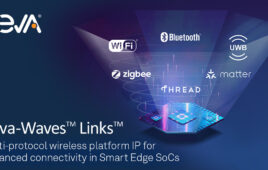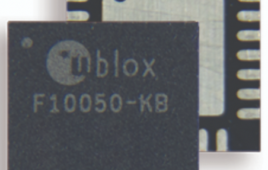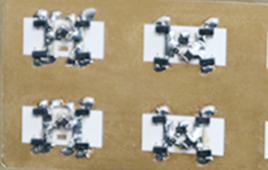MITRE’s 200th patent delivers a new way of protecting U.S. antennas from jamming and spoofing—making our enemies work harder to interfere with our signals. The technology improves an antenna’s ability to reduce satellite signal multipath interference, resulting in more accurate GPS data, which is critical both for military and civil purposes. It is among many innovations, ranging from airspace design to quantum physics, created at the not-for-profit company since its founding in 1958.
MITRE prototype designer Eddie Rosario, who’s been developing new technology at the corporation for 34 years, and Basrur Bama Rao, a prolific inventor who retired from MITRE several years ago are the patent recipients. The two worked together on many antenna designs over the years and have 20 patents between them.
Patent No. 10, 141, 638 is officially known as Conformal electro-textile antenna and electro band gap ground plane for suppression of back radiation from GPS antennas mounted on aircraft. “Our goal was to produce a small, light, adaptable solution that MITRE’s sponsors can use to carry out their missions,” says Rosario. “Bama Rao came up with the idea to use electro textiles in a new way, and I’m the hands-on guy who built the design. We tested our original prototype and a more refined one built by an outside company. Both worked as we envisioned they would—our lighter, conformable design improves on what’s being used in the field today.”
U.S. Innovation
“Patents are crucial for U.S. technological advancement, as they encourage both the creation and spread of innovations,” says Jay Schnitzer, MITRE Vice President and Chief Technology Officer. “MITRE is very proud of our patent recipients. They represent our ability to invent new solutions to our government sponsors’ problems. They enable us to broadly share our Intellectual Property (IP) for the benefit of the nation, while protecting our sponsors’ rights to it.
“We realize MITRE’s number of patents is relatively small compared to companies such as IBM and Google. However, there are many other ways to protect IP, including copyrights and trademarks, and MITRE has a strong licensing program,” adds Schnitzer.
In developing electro-textile ground planes for multipath and interference mitigation in GNSS antennas, Rosario and Rao applied their deep technical knowledge to create a new use for a material first introduced more than 20 years earlier, electro-textiles. This low-cost, lightweight, and flexible material can suppress both edge and curved surface diffraction effects, which can degrade the radiation pattern of Global Navigation Satellite System (GNSS) antennas. GNSS includes not just GPS, but other regional systems, such as GLONASS and Galileo.
The radiation patterns of GNSS antennas used in commercial and military navigation systems are affected by diffraction from either the edges of a planar metal ground plane or from curved surface diffraction generated by “creeping waves” that radiate energy as they propagate around the fuselage of an aircraft. These diffraction effects cause antenna back lobes that make the antenna susceptible to interference and multipath that degrade the accuracy of high-precision GNSS measurements.
This patent describes two types of thin, lightweight and flexible resistivity tapered ground planes made from electro-textiles, which offer a low cost and broadband solution for mitigation of antenna back lobes and pattern distortions created by these diffraction effects.
“Submitting a patent application takes hard work and patience on behalf of the inventor,” says Barry Costa, director of MITRE’s Partnerships and Technology Transfer office. “Our goal is to create impact with our intellectual property—that is, to develop applied technology and get it into the hands of our sponsors and stakeholders so that, ultimately, our technology leads to a safer world.”




